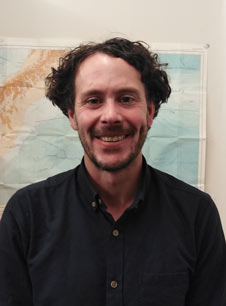Tuesday 29 January 2019 8:51am

Dr Robert Smith
Fish normally seen in sub-tropical waters arrived; the kelp that provides habitat for other fish and marine species died off; farmed salmon failed to thrive – even surfers could wear board shorts instead of wetsuits.
These were some effects seen on the coastal waters around Dunedin and the South Island during last summer’s “unprecedented” 2017–18 heatwave when the usually cooler waters of the Tasman Sea and southwest Pacific Ocean warmed by up to 3–5 degrees above average, according to a new study looking at the causes and effects of this heatwave.
The New Zealand, Australian and US collaboration was led by climate scientist Dr Jim Salinger, and involved scientists from Otago’s Marine Science, Geography and Surveying Departments, as well as from Victoria University and NIWA.
The analysis of atmospheric and oceanic data sets by scientists from Victoria University of Wellington, the National Institute of Water and Atmospheric Research (NIWA), the National Oceanic and Atmospheric Agency (NOAA), USA, the University of Otago and the University of New South Wales revealed the “unprecedented” combined ocean-atmosphere heatwave was driven by the dual effects of warm atmospheric air and low wind speeds, which would usually have a cooling effect on the sea.
The study shows seawater temperatures around the South Island turned almost sub-tropical during last summer’s heatwave (2017–18), with waters of the Tasman Sea warming on average by 3.7 degrees above normal (16.9 degrees) to reach 20.6 degrees, providing a glimpse of the future under climate change.
Sub-tropical fish species not usually seen around Dunedin, such as Kingfish, were caught by Port Chalmers fishermen, and as far south as Bluff, in numbers unheard of, up to 12 a day, compared to the usual one or two in an entire summer season.
Kelp forests along Otago’s coastline, which provide habitat, food and nursery grounds for fish and species dwelling on the sea floor, were unusually absent; numbers of salmon harvested for the salmon fisheries at the top of the South Island plummeted as the water became too warm for them; and mountain snow melted the fastest on record for a summer. Even grapes matured quicker than usual.
“If you were a surfer, you could wear board shorts instead of a wetsuit in Dunedin – almost unheard of – with sea temperatures around the 20–21 degree mark at St Clair,” says one of the researchers, University of Otago Physical Oceanographer Dr Robert Smith.
“This is what some children today can expect to see in their lifetimes.
“This multi-disciplinary work has shown that regional heatwaves can develop rapidly and have widespread impacts on ecosystems,” he says.
Associate Professor Chris Hepburn of Otago’s Department of Marine Science says there is a lack of coherent monitoring of marine ecosystems across New Zealand.
However, the long-term Portobello Marine Lab sea surface temperature data set has been key to understanding the latest heatwave, and provides a glimpse into a future of high CO2 in our oceans.
“The impacts of heatwaves like this on aquaculture is driving the salmon industry to look at new locations in southern New Zealand, including offshore Otago. These changes mean that traditional areas for fisheries and aquaculture will shift. There will be winners and losers in this process,” Associate Professor Hepburn says.
The study, just published online in Environmental Research Letters, showed that foresight of early scientists at Portobello Marine Laboratory in measuring Otago Harbour’s temperature every day since 1953 was crucial for the new and startling knowledge the study provides.
The temperature recordings by Otago Marine Science at Portobello revealed the most intense heating of southern coastal waters occurred during mid-January, maxing out at 21.3 degrees, 5.2 degrees warmer than the 30-year (1981-2011) average of 16.1 degrees for the time of year. The heatwave, in which scientists this time could recover near-real-time data, extended across the central and southern Tasman Sea and into the southwest Pacific Ocean, covering 4 million square kilometres, equivalent to the size of the Indian sub-continent.
“Based on atmospheric and ocean metrics, the summer of 2017–2018 heatwave was the most intense on record, dating back to when records began,” the study says.
The study notes that recent modelling of the 2017/18 heatwave carried out in parallel by Australian-based scientists shows that it is most likely the heatwave would not have happened without anthropogenic (man-made) influence. The effects of it also provide a glimpse into what would be expected to occur in this part of the world in future summers between 2081 and 2100.
Using satellite data Surveying and Geography researchers Dr Pascal Sirguey and Associate Professor Nicolas Cullen found that the heatwave and associated long period of settled weather caused the largest annual volume loss of permanent ice in 57 years, contributing heavily to a decline in the ice measured on these mountains since 1962.
The effect on viticulture was also assessed, with an advancement in flowering and, separately, maturation dates for grapes. Grape vines flowered 13 days earlier than usual, and grapes matured 17 days earlier.
*The contribution of Dr Elizabeth (Betty) Batham is recognised in establishing the long-term Portobello Marine Laboratory records used for this study.
For more information, please contact:
Dr Robert Smith
Department of Marine Science
University of Otago
Email: robert.smith@otago.ac.nz
